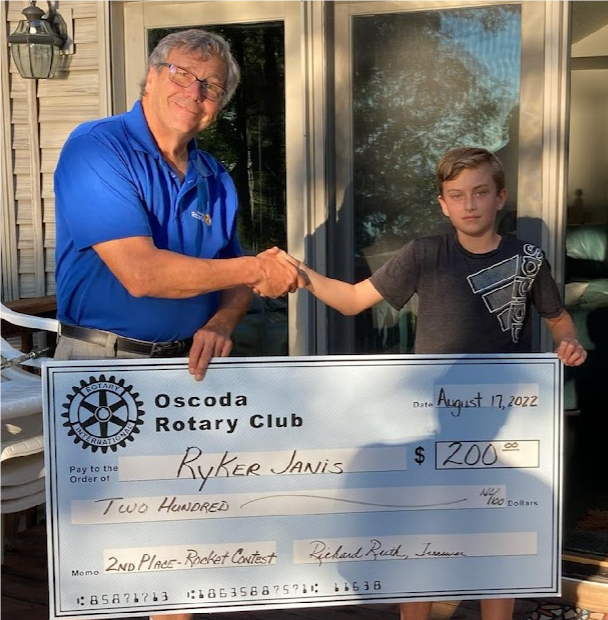Oscoda Rotary’s 2nd annual rocket contest asked chance takers to guess how high their model rocket would go for $10/chance to raise money for local school leadership development and technology. The contest rocket was launched at high noon on Sunday, Aug 14 in front of a crowd of about 50 rocket enthusiasts. The rocket went 549 feet high and the recovery system worked perfectly, with the parachute opening as designed at about 400 feet. In reviewing the contest entries, no one guessed the correct 549 feet but 6 people guessed 550 feet. The tiebreaker was how far away the rocket came down from the launch pad. While the rocket had angled slightly into the wind (known as “wind cocking”), once the parachute was out the stronger than expected wind aloft blew the rocket to a landing 247 feet down wind from the launch pad. The closest guess was 230 ft, followed by 210 and 150ft.

Contest Chairman Rick Ruth with 2nd place winner Ryker Janis

3rd place winner Bob Wilkie with the backup rocket
First place winner Mary Bochanek, daughter of Lindsay Bohanek of Waterford, MI. She wins $500 and the contest rocket. Second place winner of $200 is Ryker Janis, son of Sarah and Ron Janis, proprietors of Oscoda Septic. Third place winner of the backup rocket are Bob and Jill Wilkie, summer residents of Lakewood Shores.
Upon receiving the check, Ryker’s father Ron said “We’re just so thankful for everything Rotary does in our community”. The wind was predicted at a light 6 mph ENE so the largest possible engine, an E12-4, was placed into the rocket. To keep the contest fair, chance takers were not allowed to weight the rocket but were allowed to hold it to estimate the weight. Using the actual rocket weight and the estimated aerodynamic drag based on the rocket diameter, online rocket simulation programs predicted the rocket would go to 604 ft. Of course, there is always variation based on the weather of the day and engine to engine variations, even those labeled the same., so the resulting 549 feet was within the margin of simulation error.
The simulations also predicted the rocket would reach a speed of 122 mph, but instrumentation said it achieved 126 mph. Max acceleration was 9.1G. The rocket took just over 6 seconds to reach its peak altitude, then the recovery system was ejected. At first the parachute was held closed by an electronic chute release, which opened at 400 ft. Then the parachute fully opened and the rocket came down at 12 mph. The total flight duration was 35 seconds, 6 seconds up and 29 seconds down. Using the chute release helped insure the rocket didn’t drift into the trees.
The contest raised $2,000 for school leadership and technology programs, more than twice as much as last year. Rotary President Pam Harkema said “We are grateful for the community support of Rotary that helps us to help our schools. The rocket contest was a great reminder to aim high to push ourselves to greater heights of service to our community.”
A public launch of the NorthEast Michigan Rocket Association preceeded the contest launch. One of the rockets brought by a club member went so high, the wind took it OVER the trees by the bus garage. The recovery team expected to find it in the practice soccer field behind the bus garage, but it was not found! The next public launch is set for Saturday, Sept 3, from 9 to 11am at the OHS athletic complex. All are welcome.
